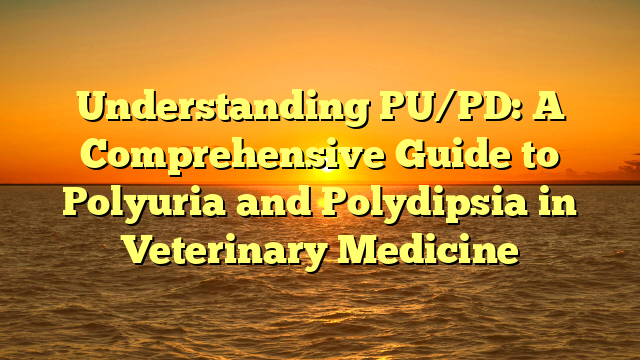Understanding PU/PD: A Comprehensive Guide to Polyuria and Polydipsia in Veterinary Medicine
Introduction
Polyuria and polydipsia, commonly referred to as PU/PD, are two clinical signs that are frequently encountered in veterinary medicine. These symptoms can be indicative of various underlying conditions and can pose a diagnostic challenge for veterinarians. In this comprehensive guide, we will delve into the intricacies of PU/PD, exploring its causes, diagnostic approach, and treatment options.
What is PU/PD?
Polyuria refers to an excessive production of urine, while polydipsia refers to increased thirst and water consumption. When these two symptoms occur together, they are often referred to as PU/PD. PU/PD can be a result of various physiological and pathological processes, and it is crucial to identify the underlying cause in order to provide appropriate treatment.
Causes of PU/PD
There are numerous potential causes of PU/PD in veterinary medicine. Some of the most common include:
- Diabetes mellitus: This endocrine disorder is characterized by the body’s inability to regulate blood sugar levels. Increased urine production and thirst are common symptoms in diabetic animals.
- Renal disease: Conditions such as chronic kidney disease or acute kidney injury can lead to impaired kidney function, resulting in PU/PD.
- Hyperadrenocorticism: Also known as Cushing’s disease, this condition is caused by excessive production of cortisol. PU/PD is a common clinical sign in animals with hyperadrenocorticism.
- Pyometra: This is a uterine infection that can cause hormonal imbalances, leading to increased urine production and thirst.
- Hypercalcemia: Elevated levels of calcium in the blood can result in PU/PD.
Diagnostic Approach
When presented with a patient exhibiting PU/PD, veterinarians employ a systematic diagnostic approach to identify the underlying cause. This typically involves a combination of thorough history-taking, physical examination, and laboratory tests.
History-taking
Obtaining a detailed history from the pet owner is crucial in understanding the onset, duration, and progression of PU/PD. Questions regarding changes in appetite, weight loss, vomiting, or any other accompanying symptoms can provide valuable clues.
Physical examination
A comprehensive physical examination is essential to identify any abnormalities that may be contributing to PU/PD. This may include palpation of the abdomen, evaluation of the urinary system, and assessment of hydration status.
Laboratory tests
Laboratory tests play a vital role in diagnosing the underlying cause of PU/PD. These may include:
- Complete blood count (CBC): This test provides information about the red and white blood cell counts, which can help identify infections or anemia.
- Biochemical profile: This panel of tests evaluates organ function, including kidney and liver function, which can be helpful in identifying renal disease or hormonal imbalances.
- Urinalysis: Analysis of the urine can provide valuable information about kidney function, the presence of infection, or the presence of glucose, which may indicate diabetes mellitus.
- Hormone testing: Depending on the suspected underlying cause, specific hormone tests may be performed to assess adrenal or thyroid function.
Treatment Options
The treatment of PU/PD depends on the underlying cause. Once a diagnosis has been made, veterinarians can develop an appropriate treatment plan. Some common treatment options include:
Diabetes mellitus
For animals diagnosed with diabetes mellitus, treatment typically involves insulin therapy, dietary management, and regular monitoring of blood glucose levels.
Renal disease
Treatment for renal disease may include dietary modifications, fluid therapy, and medications to manage symptoms and slow the progression of the disease.
Hyperadrenocorticism
In cases of hyperadrenocorticism, treatment options may include medication to suppress cortisol production or surgical removal of adrenal tumors.
Pyometra
Pyometra is typically treated with surgical removal of the infected uterus, along with appropriate antibiotic therapy.
Hypercalcemia
Treatment for hypercalcemia may involve addressing the underlying cause, such as removing a parathyroid tumor or managing calcium levels through dietary modifications and medication.
Conclusion
Polyuria and polydipsia are common clinical signs encountered in veterinary medicine. Understanding the underlying causes of PU/PD is crucial in providing appropriate treatment and improving the quality of life for affected animals. By employing a systematic diagnostic approach and considering the various treatment options available, veterinarians can effectively manage PU/PD and improve patient outcomes.











